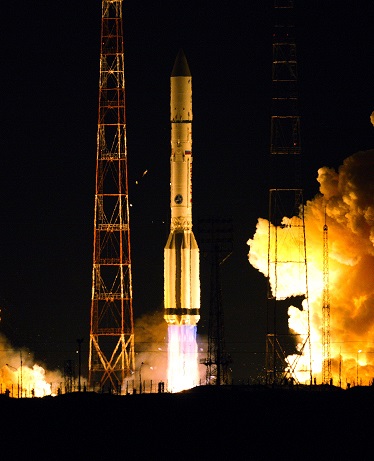Gazprom Space Systems' Yamal-401 Satellite Successfully Launched
Baikonour Cosmodrome, Kazakhstan, December 15, 2014 – International Launch Services (ILS), successfully launched Gazprom Space Systems' Yamal-401 satellite into geosynchronous orbit today on a Proton rocket. This was the landmark 400th mission for the Proton launch vehicle since its first flight in 1965.

The satellite, weighing nearly 3 metric tons, was built by JSC ISS Reshetnev on the Express 2000-A platform. In collaboration with ISS Reshetnev, Thales Alenia Space was responsible for the repeater, antennas, parts of the satellite platform, and support to the customer for satellite AIT in Siberia and Baïkonur.
At an orbital location of 90° East longitude, the Yamal 401 communications satellite will provide services to users in Russia and CIS countries. The total capacity of the Yamal 401 satellite will amount to 53 physical transponders or 88 equivalent (36 MHz) transponders, which will compose one fixed beam in C band and two fixed beams in Ku band.
Phil Slack, President of ILS commented, “We thank Gazprom for the opportunity to launch this important satellite and to help expand their business with the launch of Yamal 401, the second launch for Gazprom by ILS. We are grateful for the mission teams of Gazprom, ILS, Khrunichev, ISS Reshetnev and Thales Alenia Space for their dedication to mission success throughout the entire campaign.”
This was the 86th ILS Proton mission overall and the 2nd ILS Proton launch of 2014. The Proton Breeze M vehicle is developed and built by Khrunichev State Research and Production Space Center of Moscow, the majority shareholder in ILS.
The Yamal-401 satellite's combined payload consists of 17 standard C-band 72 MHz, 18 standard Ku-band 72 MHz and 18 “planned” Ku-band 36 MHz transponders. So, the total Yamal-401 satellite capacity will be 53 transponders or 88 equivalent 36 MHz transponders.
Two fixed contoured beams are formed to operate in Ku-band Northern beam covers not only all the visible territory of Russia but neighboring countries as well. The highest power of this beam will be focused on the most populated territory of Russia. Transponders with standard bandwidth (eighteen 72 MHz transponders) are planned to be used in Northern beam.
Related Articles:
- Interview with Gazprom Space Systems' Director-General Dmitry Sevastiyanov
- World Teleport Association Publishes Top Operator Rankings for 2014
- Ready for Primetime: Gazprom Space Systems
- Modest Revenue Growth for Commercial FSS Operators in 2013
- Interview with Gazprom Space Systems' Deputy Director-General Igor Kot





